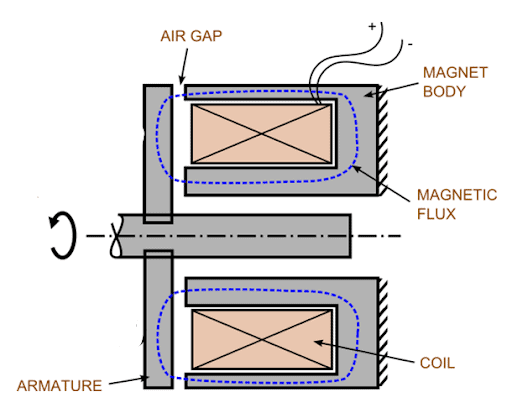
There are two basic types of Electromagnetic Brakes. “Power On” (Magnetically Applied) and
“Power Off” (Spring Applied). Most brakes (covering several markets) work with Direct Current applied (DC). 24VDC is popular.
When power is applied an Electromagnetic Field is generated. This field has a normal force
created by the strength of the coil (magnetic flux) like a DC brushless motor. The force in the case of a “Power Off” brake must be strong enough to overcome a spring force.
In the case of a “Power On” Brake the force created must be strong enough to generate a clamping force engaging friction surfaces to generate torque. In the case of a tooth type brake, strong enough to generate a clamping force to keep tooth faces engaged generating torque.
What Are Electromagnetic Brakes?
Electromagnetic brakes use electromagnetic forces to hold loads in place. There are several types of electromagnetic brakes available, each of which operate on the same principle of applying an electrical current through an electromagnetic coil to generate a magnetic field with enough strength to move the armature off or on the magnetic face. The braking force is created by the friction surface.
An example of a “Power On” (Magnetically Applied) brake includes:
- Magnetically Applied Tooth Brake. This magnetically applied tooth brake is designed to operate both dry and in oil. It can be piloted either on the outside diameter or magnet body bore.
Two common types of “Power Off” (Spring Applied) brakes include both friction brakes and tooth brakes. While they serve the same function, they do so differently.
- Friction brakes. Friction brakes use friction discs to transmit torque upon compression, holding or stopping the load when the power is off.
- Tooth brakes. Spring-applied tooth brakes utilize springs to force the teeth of the armature into engagement when the current is removed.
Electromagnetic Brake Applications
Electromagnetic brakes are preferred across a wide range of industries because of their cleanliness, control, and safety, especially for various robotics applications. Electromagnetic brakes for robotics systems serve to halt movement and apply holding torque. Some of the most common applications include:
- Aerospace. Electromagnetic brakes provide fine-tuned control in unmanned aircraft.
- Agriculture. Electromagnetic brakes are used in agricultural robotics systems such as fruit-picking robots and other complex automated technologies.
- Medical. Electromagnetic brakes maintain torque for fine control of surgical tools and complex three-dimensional motions.
- Military. Electromagnetic brakes can control the loads in specialized unmanned vehicles, like bomb response robots, for fine-tuned control and motion.
- Oil and Gas. This industry uses unmanned vehicles for subsea and subterranean operations. Power Off brakes allow for controllable motion on uneven surfaces and while holding variable loads.
- UAV/UVG Vehicles. A wide range of vehicles use electromagnetic brakes for controlling motion and halting movement. Automated and unmanned vehicles rely on electromagnetic brakes rather than traditional mechanical brakes.
Electromagnetic Brakes From SEPAC
At SEPAC, we specialize in providing high-performance, reliable electromagnetic braking solutions to suit a wide range of application requirements. For more information about our product offerings, contact the experts at SEPAC, or request more information to start your project.